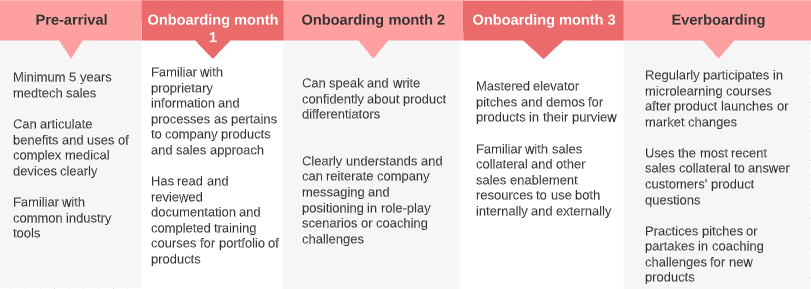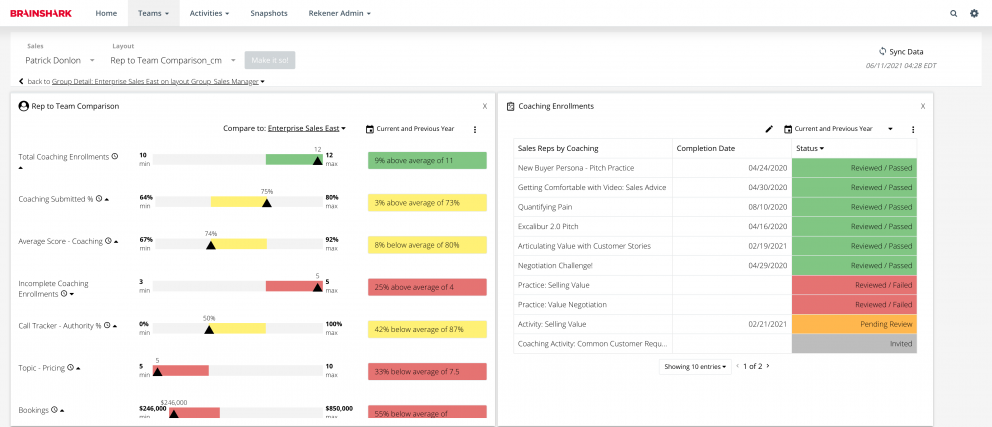Time to competency: the new essential metric in sales onboarding

While employee cutbacks and attrition are widespread across sectors and roles at the moment, these numbers are especially concerning for sales— a department with historically high turnover at the best of times. In a webinar with former Bigtincan CMO Rusty Bishop, Forrester Principal Analyst Eric Zines explained why attrition is so bad for sales in particular. “Because of quota attainment,” said Zines. “If a seller leaves and there’s a spot open, that quota isn’t covered or it’s split up by others on the team halfheartedly.”
Zines also offered a solution to sales and enablement leaders seeking to stem the flow, saying, “What sales leaders can do better to reduce attrition is to increase onboarding quality and time by focusing on trying to measure time to competency.”
But what exactly does time to competency mean, how do you track it, and most importantly, how do you improve it?
Follow The Blueprint for Better Sales Onboarding to efficiently and effectively onboard your sales team to guarantee long-term results.
What is time to competency in sales onboarding?
“Competency refers to the skills, knowledge, or processes that sales reps need to master to meet the expectations of their job” (source).
Traditional sales onboarding metrics fall short in accounting for a new employee’s competency level. That’s why analysts are citing time to competency as the new essential metric in sales onboarding for not only accelerating onboarding but retaining sales talent.
Unlike traditional sales onboarding metrics such as time to quota or time to first sale, time to competency doesn’t have hard and fast rules, at least not when you first implement it. While still a leading metric (one that can be measured as a direct outcome of your activities), time to competency is more of a holistic metric that, when implemented correctly, leads to “more effective initiatives to up-level the skills of the sales organization” (source).
So why is time to competency so important? According to Sales Enablement Pro, “Prioritizing competency is necessary for sellers to keep up with the pace of rapid change in the modern selling environment.” Market conditions change, sales methodologies go in and out of style, but sales competencies like written communication, active listening, negotiation, and research, to name a few, are evergreen and transferable, regardless of trends and circumstances.
Compared to what Sales Enablement Pro calls “activity-based metrics” that look at the number of calls made, demo sessions booked, or emails sent, time to competency is instead a skill-based metric which may be less quantifiable upfront but more valuable in the long run. Using a more holistic or arbitrary metric such as time to competency naturally compensates for variables across organizations such as territory, products, and customer base (enterprise vs. mid-market,etc.).
A focus on competency is also a core part of the Sales Talent Lifecycle as defined by Forrester research, represented here:
| Sales Talent Lifecycle | |
| Phase 1- Attract | Decide which competencies you want in your team |
| Phase 2- Onboarding | Teach competencies to new hires before putting them in front of the customer |
| Phase 3- Ongoing learning and development | Develop competencies over time to help employees excel in the job they have or prepare them for the next leadership role |
Research also shows that employers who focus on developing employee competencies tend to have lower churn rates. It demonstrates they are valued enough for you to invest in their career development, a key factor in reducing employee turnover according to recent reports from staffing experts LinkedIn, BambooHR, and others.
How do you measure time to competency as an onboarding metric?
Looking at each of the phases in the Sales Talent Lifecycle, you can see why time to competency must be defined differently at each organization.
How you measure it will depend on which competencies you’ve selected and the average time it takes new sales reps at your company to reach the level of success you’ve determined is necessary before going out into the field. This will depend on how complex your products or services are, the experience level and industry knowledge of new hires, and how efficiently your sales and enablement teams train new hires in skills.
There will be a trial and error period before you can establish standard benchmarks for time to competency at your company. You should also consider different competencies or levels of competency for each stage of onboarding and the Sales Talent Lifecycle.
Common sales skills and competency areas might include:
- Product knowledge and positioning
- Pitching and delivering messaging
- Identifying prospect objectives
- Gaining customer trust and building customer relationships
- Written communication
- Using CRMs and other tools
If you follow the recommendation that your onboarding timeline mirror your sales cycle and you have a three-month sales cycle, a framework for measuring time to competency for an account executive’s product knowledge of medical devices might look like the following:

Keep in mind that competencies such as product knowledge or competitive intelligence have to be actively maintained since they are areas of frequent change. That’s where everboarding or continuing learning and coaching comes in.
In most cases, effectively measuring a more holistic metric like time to competency and scaling your onboarding process requires sales enablement tools. If you don’t have sales training tools in place or the means to acquire them right now but want to start testing out time to competency as an onboarding metric, you can start with role-play scenarios, regular 1:1s between sales reps and sales managers, and performance reviews.
Tools and training methods for accelerating employee onboarding
According to the recruiting experts at Monster.com, the imbalance of so many vacant positions and so few qualified candidates to fill them means companies can no longer hire for all of the competencies they may have required in the past. They hire the best they can and devote time to building those competencies in-house. As Zines put it, “The baseline for competencies could be all over the board.”
But effectively building competencies requires the right tools.
“Sales enablement has a critical role to play in maximizing sales rep competency, all the way from bringing great sales talent in the door to nurturing their skills through training,” writes Sales Enablement Pro. “For top-performing sellers, it is something that they now expect from their companies.”
You can reinforce, train, and track the core competencies you have defined for the sellers at your organization through sales enablement tools like those listed below.
Sales rep scorecards
Sales rep scorecards track individual improvement in training and sales processes, offering a holistic, comprehensive view that looks at more than just demos booked. Scorecards combine data from a sales rep’s training courses, curriculums, coaching challenges, conversation intelligence, and more, and enhance it with performance data from your CRM all tied specifically to the individual.

Scorecards help diagnose the reps who are not completing programs or struggling to master certain competencies. They also make it possible to easily share information with sales managers and collaborate with reps to ensure they are getting the training they need.
Conversation Intelligence
Conversational Intelligence trains and tracks competency in perfect pitches, how sellers interact with the customer, their tone and persona during sales calls, how often and how well they listen, and more. Conversational Intelligence is a great tool for scaling onboarding and training programs that build conversational competencies without eating up all of your sales managers’ time.
Sales Coaching
Sales coaching tools allow you to leverage machine learning (in some cases) as well as your high performers and sales leaders to pass on their skills. They also help sales leaders develop their own skills as coaches, managers, and teachers, which helps with their career development and their loyalty to your organization.
Certifications
Offering a formal certification program is a differentiator that helps attract and retain top sales talent. Certifications confirm that sellers have achieved working competency in different sales skills. They also serve as a career development tool that not only helps employees long term but shows them your company is invested in their growth beyond the impact on your own organization.
Courses and curriculums
Building custom courses and curriculums is the perfect way to guarantee that sellers are working toward the specific core competencies necessary to excel at your company. “Courses and curriculums completed” also serves as a concrete and measurable onboarding metric to factor into time to competency assessments.
Games and quizzes
Gamification of sales training, when utilized strategically around targeted learning initiatives in certain sales environments, can have a great impact on sales competencies. Gamification also tracks learning milestones and offers reps rewards for their efforts.
Customer Feedback
Don’t forget your most valuable source of information where your sales reps are concerned— your customers! Praise for customer experience and support during the sales process is a great (free!) gauge of how competent your sales reps are. If you aren’t tracking customer feedback, start now!
The takeaway here is that improving sales onboarding is not only about getting new employees up to speed faster, but a method of reducing turnover and retaining top sales talent. If you focus on improving sales skills and building onboarding programs around time to competency, the numbers will follow— and your high performers will stay. They may even recruit their friends.
Want to improve onboarding and and training at your company but don’t know where to start or how to get your leadership on board? The Business Case and Playbook for Data-Driven Sales Coaching will serve as a springboard for your business case, playbook, and implementation plan as you consider an investment of time and money to launch a data-driven sales coaching program at your company. You can also speak to one of our experts about your sales training challenges and how to overcome them.

